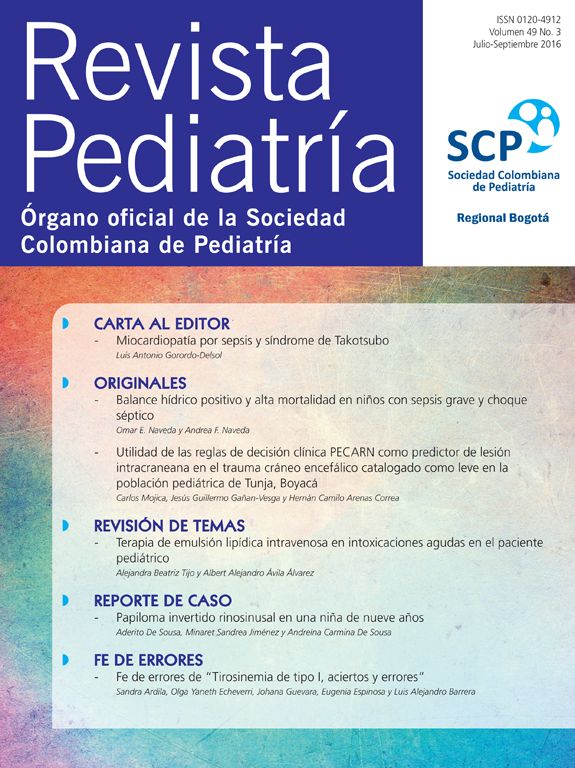Positive fluid balance and high mortality in paediatric patients with severe sepsis and septic shock
Main Article Content
Abstract
DOI: 10.1016/j.rcpe.2016.06.001
Introduction
In severe sepsis and septic shock one of the mainstays of treatment is the administration of intravenous fluids. However, the administration of excess fluids in sepsis may have deleterious effects.
Methods
A prospective observational cohort study was performed in order to determine if the fluid balance has a determining impact on mortality rate in a group of critically ill children with severe sepsis or septic shock.
Results
A total of 102 patients were included in the analysis. Severe sepsis was predominant in 61.8% of the cases. The mortality was 25.5%. The fluid balance was significantly higher at 48hours and 72hours in non-survivors, as well as the accumulated fluid balance in the first 72hours (1973±868ml vs. 1044±670ml, p<.0001).
Using a multivariate Cox regression model, a PELOD (Paediatric Logistic Organ Dysfunction) score of more than 20 points (HR=2.9; 1.7–11.4; p=.014), acute renal failure (HR=1.9; 95% CI; 1.1–3.8; p=.001), and fluid overload (HR=2.1; 95% CI; 1.3–8.2; p=.035) were identified as predictors of mortality at 28 days. A significantly increased risk of mortality in children with fluid overload (p=.002) is also observed in the survival curve using the Kaplan-Meier method.
Conclusions
The accumulated positive fluid balance in the first 72hours is associated with higher mortality in children with severe sepsis or septic shock. PELOD score, acute renal failure, and fluid overload increase the risk of mortality in these patients.
Downloads
Article Details
Creative Commons
License Attribution-NonCommercial-ShareAlike 4.0 International (CC BY-NC-SA 4.0)
You are free to:
Share - copy and redistribute the material in any medium or format.
Adapt - remix, transform, and build upon the material The licensor cannot revoke these freedoms as long as you follow the license terms.
• Attribution — You must give appropriate credit, provide a link to the license, and indicate if changes were made. You may do so in any reasonable manner, but not in any way that suggests the licensor endorses you or your use.
• NonCommercial — You may not use the material for commercial purposes.
• ShareAlike — If you remix, transform, or build upon the material, you must distribute your contributions under the same license as the original.
• No additional restrictions — You may not apply legal terms or technological measures that legally restrict others from doing anything the license permits.
References
Patient and hospital correlates of clinical outcomes and resource utilization in severe pediatric sepsis
Pediatrics., 119 (2007), pp. 487-494 http://dx.doi.org/10.1542/peds.2006-2353
Medline
2 S.L. Valentine,A. Sapru,R.A. Higgerson,P.C. Spinella,H.R. Flori,D.A. Graham
Fluid balance in critically ill children with acute lung injury
Crit Care Med., 40 (2012), pp. 2883-2889 http://dx.doi.org/10.1097/CCM.0b013e31825bc54d
Medline
3 J.H. Boyd,J. Forbes,T.A. Nakada,K.R. Walley,J.A. Russell
Fluid resuscitation in septic shock: A positive fluid balance and elevated central venous pressure are associated with increased mortality
Crit Care Med., 39 (2011), pp. 259-265 http://dx.doi.org/10.1097/CCM.0b013e3181feeb15
Medline
4 J.M. Sirvent,C. Ferri,A. Baró,C. Murcia,C. Lorencio
Fluid balance in sepsis and septic shock as a determining factor of mortality
Am J Emerg Med., 33 (2015), pp. 186-189 http://dx.doi.org/10.1016/j.ajem.2014.11.016
Medline
5 R.P. Dellinger,M.M. Levy,A. Rhodes,D. Annane,H. Gerlach,S.M. Opal
International guidelines for management of severe sepsis and septic shock: 2012
Crit Care Med., 41 (2013), pp. 580-637 http://dx.doi.org/10.1097/CCM.0b013e31827e83af
Medline
6 D.C. Angus,W.T. Linde-Zwirble,J. Lidicker,G. Clermont,J. Carcillo,M.R. Pinsky
Epidemiology of severe sepsis in the United States: Analysis of incidence, outcome, and associated costs of care
Crit Care Med., 29 (2001), pp. 1303-1310
Medline
7 R.S. Watson,J.A. Carcillo,W.T. Linde-Zwirble,G. Clermont,J. Lidicker,D.C. Angus
The epidemiology of severe sepsis in children in the United States
Am J Respir Crit Care Med., 167 (2003), pp. 695-701 http://dx.doi.org/10.1164/rccm.200207-682OC
Medline
8 S.T. Micek,C. McEvoy,M. McKenzie,N. Hampton,J.A. Doherty,M.H. Kollef
Fluid balance and cardiac function in septic shock as predictors of hospital mortality
Critical Care., 17 (2013), pp. R246 http://dx.doi.org/10.1186/cc13072
Medline
9 J.A. Myburgh
Fluid resuscitation in acute illness-time to reappraise the basics
N Engl J Med., 364 (2011), pp. 2543-2544 http://dx.doi.org/10.1056/NEJMe1105490
Medline
10 C. Ronco,J.A. Kellum,R. Bellomo,A.A. House
Potential interventions in sepsis-related acute kidney injury
Clin J Am Soc Nephrol., 3 (2008), pp. 531-544 http://dx.doi.org/10.2215/CJN.03830907
Medline
11 H.R. Flori,G. Church,K.D. Liu,G. Gildengorin,M.A. Matthay
Positive fluid balance is associated with higher mortality and prolonged mechanical ventilation in pediatric patients with acute lung injury
Crit Care Res Pract., 2011 (2011), pp. 854142 http://dx.doi.org/10.1155/2011/854142
Medline
12 A.A. Arikan,M. Zappitelli,S.L. Goldstein,A. Naipaul,L.S. Jefferson,L.L. Loftis
Fluid overload is associated with impaired oxygenation and morbidity in critically ill children
Pediatr Crit Care Med., 13 (2012), pp. 253-258 http://dx.doi.org/10.1097/PCC.0b013e31822882a3
Medline
13 R.J. Trof,A. Beishuizen,A.D. Cornet,R.J. de Wit,A.R. Girbes,A.B. Groeneveld
Volume-limited versus pressure-limited hemodynamic management in septic and nonseptic shock
Crit Care Med., 40 (2012), pp. 1177-1185 http://dx.doi.org/10.1097/CCM.0b013e31823bc5f9
Medline
14 J.L. Vincent,D. De Backer
Circulatory shock
N Engl J Med., 369 (2013), pp. 1726-1734 http://dx.doi.org/10.1056/NEJMra1208943
Medline
15 C.V. Murphy,G.E. Schramm,J.A. Doherty,R.M. Reichley,O. Gajic,B. Afessa
The importance of fluid management in acute lung injury secondary to septic shock
Chest., 136 (2009), pp. 102-109 http://dx.doi.org/10.1378/chest.08-2706
Medline

